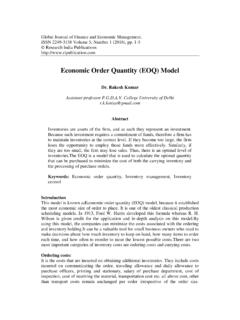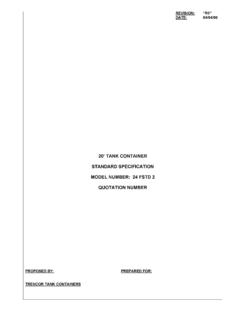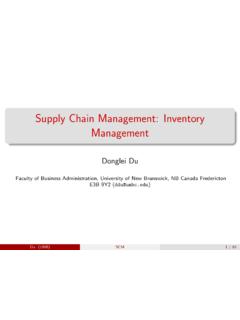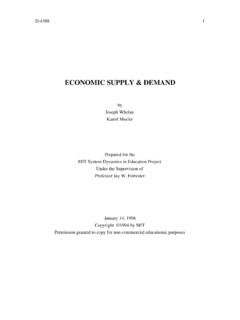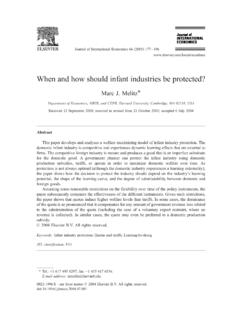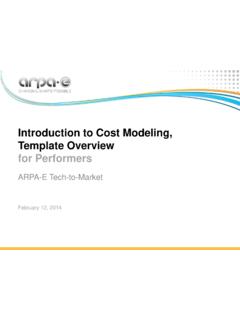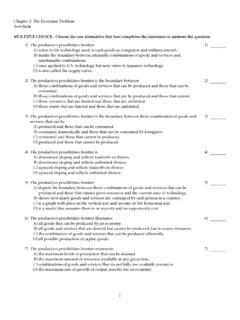Transcription of Bertrand Model of Price Competition
1 Bertrand Model of Price Competition Advanced Microeconomic Theory1 Bertrand Model of Price Competition Consider: An industry with two firms, 1 and 2, selling a homogeneous product Firms face market demand ( ), where ( )is continuous and strictly decreasing in There exists a high enough Price (choke Price ) < such that ( )=0for all > Both firms are symmetric in their constant marginal cost >0, where (0, ) Every firm simultaneouslysets a Price Advanced Microeconomic Theory2 Bertrand Model of Price Competition Firm s demand is ( , )= ( )if < 12 ( )if = 0if > Intuition: Firm captures all market if its Price is the lowest, < no market if its Price is the highest, > shares the market with firm if the Price of both firms coincide, = Advanced Microeconomic Theory3 Bertrand Model of Price Competition Given prices and , firm s profits are therefore( ) ( , ) We are now ready to find equilibrium prices in the Bertrand duopoly Model .
2 There is a unique NE ( , )in the Bertrand duopoly Model . In this equilibrium, both firms set prices equal to marginal cost, = = .Advanced Microeconomic Theory4 Bertrand Model of Price Competition Let s us describe the best response function of firm . If < , firm sets its Price at = . Firm does not undercut firm since that would entail negative profits. If < < , firm slightly undercuts firm , , = . This allows firm to capture all sales and still make a positive margin on each unit. If > ,where is a monopoly Price , firm does not need to charge more than , , = . allows firm to capture all sales and maximize profits as the only firm selling a positive Microeconomic Theory5pjpkpmpmccpj (pk)45 -line (pj = pk) Bertrand Model of Price Competition Firm s best response has: a flat segment for all < , where ( )= a positive slope for all < < , where firm charges a Price slightly below firm a flat segment for all > , where ( )= Advanced Microeconomic Theory6pjpkccpj (pk)pk (pj)pmpm45 -line (pj = pk) Bertrand Model of Price Competition A symmetric argument applies to the construction of the best response function of firm.
3 A mutual best response for both firms is ( 1 , 2 )=( , )where the two best response functions cross each other. This is the NE of the Bertrand Model Firms make no economic profits. Advanced Microeconomic Theory7 Bertrand Model of Price Competition With only two firms competing in prices we obtain the perfectly competitive outcome, where firms set prices equal to marginal cost. Price Competition makes each firm face an infinitely elastic demand curve at its rival s Price , . Any increase (decrease) from infinitely reduces (increases, respectively) firm s Microeconomic Theory8 Bertrand Model of Price Competition How much does Bertrand equilibrium hinge into our assumptions? Quite a lot The competitive pressure in the Bertrand Model with homogenous products is ameliorated if we instead consider: Price Competition (but allowing for heterogeneous products) quantity Competition (still with homogenous products) Capacity constraintsAdvanced Microeconomic Theory9 Bertrand Model of Price Competition Remark: How our results would be affected if firms face different production costs, , 0< 1< 2?
4 The most efficient firm sets a Price equal to the marginal cost of the least efficient firm, 1= 2. Other firms will set a random Price in the uniform interval [ 1, 1+ ]where >0is some small random increment with probability distribution , >0for all .Advanced Microeconomic Theory10 Cournot Model of quantity CompetitionAdvanced Microeconomic Theory11 Cournot Model of quantity Competition Let us now consider that firms compete in quantities. Assume that: Firms bring their output 1and 2to a market, the market clears, and the Price is determined from the inverse demand function ( ), where = 1+ 2. ( )satisfies ( )<0at all output levels 0, Both firms face a common marginal cost >0 (0)> in order to guaranteethat the inverse demand curve crosses the constant marginal cost curve at an interior Microeconomic Theory12 Cournot Model of quantity Competition Let us first identify every firm s best response function Firm 1 s PMP, for a given output level of its rival, 2,max 1 0 1+ 2 Price 1 1 When solving this PMP, firm 1 treats firm 2 s production, 2,as a parameter, since firm 1 cannot vary its Microeconomic Theory13 Cournot Model of quantity Competition FOCs: ( 1+ 2) 1+ ( 1+ 2) 0withequalityif 1>0 Solving this expression for 1, we obtain firm 1 s best response function (BRF), 1( 2).
5 A similar argument applies to firm 2 s PMP and its best response function 2( 1). Therefore, a pair of output levels ( 1 , 2 )is NE of the Cournot Model if and only if 1 1( 2)for firm 1 s output 2 2( 1)for firm 2 s outputAdvanced Microeconomic Theory14 Cournot Model of quantity Competition To show that 1 , 2 >0, let us work by contradiction, assuming 1 =0. Firm 2 becomes a monopolist since it is the only firm producing a positive output. Using the FOC for firm 1, we obtain (0+ 2 )0+ (0+ 2 ) or ( 2 ) And using the FOC for firm 2, we have ( 2 +0) 2 + ( 2 +0) or ( 2 ) 2 + ( 2 ) This implies firm 2 s MR under monopoly is lower than its MC. Thus, 2 = Microeconomic Theory15 Cournot Model of quantity Competition Hence, if 1 =0,firm 2 s output would also be zero, 2 =0.
6 But this implies that (0)< since no firm produces a positive output, thus violating our initial assumption (0)> . Contradiction! As a result, we must have that both 1 >0and 2 >0. Note: This result does not necessarily hold when both firms are asymmetric in their production Microeconomic Theory16 Cournot Model of quantity Competition Example(symmetric costs): Consider an inverse demand curve ( )= , and two firms competing la Cournot both facing a marginal cost >0. Firm 1 s PMP is ( 1+ 2) 1 1 FOC wrt 1: 2 1 2 0withequalityif 1>0 Advanced Microeconomic Theory17 Cournot Model of quantity Competition Example(continue): Solving for 1,we obtain firm 1 s BRF 1( 2)= 2 22 Analogously, firm 2 s BRF 2( 1)= 2 12 Advanced Microeconomic Theory18 Cournot Model of quantity CompetitionAdvanced Microeconomic Theory19 Firm 1 s BRF: When 2=0, then 1= 2 , which coincides with its output under monopoly.
7 As 2increases, 1decreases( , firm 1 s and 2 s output are strategic substitutes) When 2= ,then 1= Model of quantity CompetitionAdvanced Microeconomic Theory20 A similar argument applies for firm 2 s BRF. Superimposing both firms BRFs, we obtain the Cournot equilibrium output pair ( 1 , 2 ).Cournot Model of quantity CompetitionAdvanced Microeconomic Theory21q1q2a cq1(q2)2bq2(q1)a cba cba c2ba c3ba c3b(q1,q2 ) * *45 -line (q1 = q2)q1 + q2 = qc =a cbq1 + q2 = qm =a c2bPerfect com petitionMonopoly45 Cournot Model of quantity Competition Cournot equilibrium output pair ( 1 , 2 )occurs at the intersection of the two BRFs, , ( 1 , 2 )= 3 , 3 Aggregate output becomes = 1 + 2 = 3 + 3 =2( )3 which is larger than under monopoly, = 2 , but smaller than under perfect Competition , =.
8 Advanced Microeconomic Theory22 Cournot Model of quantity Competition The equilibrium Price becomes = = 2 3 = +2 3which is lower than under monopoly, = + 2, but higher than under perfect Competition , = . Finally, the equilibrium profits of every firm = = +2 3 3 3 = 24 which are lower than under monopoly, = 24 , but higher than under perfect Competition , = Microeconomic Theory23 Cournot Model of quantity Competition quantity Competition (Cournot Model ) yields less competitive outcomes than Price Competition ( Bertrand Model ), whereby firms behavior mimics that in perfectly competitive markets That s because, the demand that every firm faces in the Cournot game is not infinitely elastic. A reduction in output does not produce an infinite increase in market Price , but instead an increase of ( 1+ 2).
9 Hence, if firms produce the same output as under marginal cost pricing, , half of 2, each firm would have incentives to deviate from such a high output level by marginally reducing its Microeconomic Theory24 Cournot Model of quantity Competition Equilibrium output under Cournot does not coincide with the monopoly output either. That s because, every firm , individually increasing its output level , takes into account how the reduction in market Price affects its own profits, but ignores the profit loss ( ,a negative external effect) that its rival suffers from such a lower Price . Since every firm does not take into account this external effect, aggregate output is too large, relative to the output that would maximize firms joint Microeconomic Theory25 Cournot Model of quantity Competition Example(Cournot vs.)
10 Cartel): Let us demonstrate that firms Cournot output is larger than that under the cartel. PMP of the cartel ismax 1, 2( ( 1+ 2)) 1 1+( ( 1+ 2)) 2 2 Since = 1+ 2, the PMP can be written asmax 1, 2 ( 1+ 2)( 1+ 2) ( 1+ 2)=max = 2 Advanced Microeconomic Theory26 Cournot Model of quantity Competition Example(continued): FOC wrt 2 0 Solving for , we obtain the aggregate output = 2 which is positive since > , , (0)= > . Since firms are symmetric in costs, each produces = 2= 4 Advanced Microeconomic Theory27 Cournot Model of quantity Competition Example(continued): The equilibrium Price is = = 2 = + 2 Finally, the equilibrium profits are = = + 2 4 4 = 28 which is larger than firms would obtain under Cournot Competition , 29.
